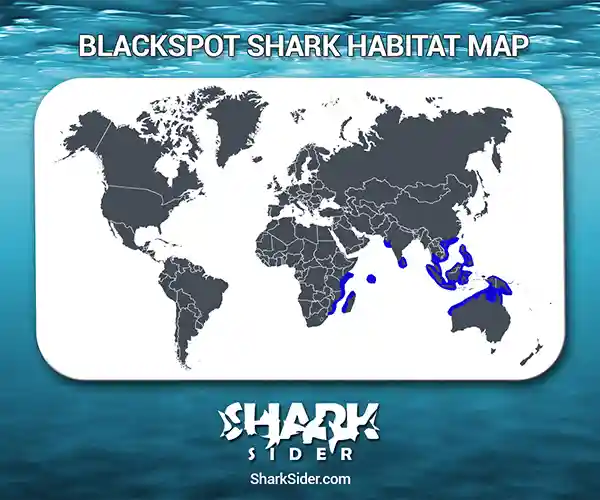The blackspot shark is found extensively across the temperate and tropical regions of the Indo-West Pacific Ocean. This small shark species belonged to the family Carcharhinidae and was named in honor of American ichthyologist Alvin Seale, who first described this shark in 1910.
Blackspot Shark Scientific Classification |
|
| Kingdom: | Animalia |
| Phylum: | Chordata |
| Class: | Chondrichthyes |
| Superorder: | Selachimorpha |
| Order: | Carcharhiniformes |
| Family: | Carcharhinidae |
| Genus: | Carcharhinus |
| Scientific Name: | Carcharhinus sealei |
Description
These sharks have a slender and streamlined body shape and can grow up to lengths of 37 in.
Their upper surface has a brown or silver-gray appearance leading to a pale grayish underside. A faint pale stripe runs through the flank side of the shark. There is the presence of a large, triangle-shaped spot that is black and covers most of the second dorsal fin.
They have an elongated snout that is slightly blunt at the tip. The head consists of a pair of large, oval, horizontal eyes that are protected with nictitating membranes on the lower side; nostrils are covered with triangular flaps of skin.
Their mouths have furrows on the corner of their lips (furrows on the upper lip are short). There are 11-13 tooth rows present inside both jaws. While the teeth in the lower jaws have oblique, serrated, or smooth cusps, the upper teeth are made of strongly serrated cusps flanked by smooth-edged cusplets.
There are five pairs of gill slits on both sides of the head, with the hindmost gill slit originating above the origin of the pectoral fins. They have a long, narrow, and angled short rear tip on the first dorsal fin, which is blunt or sometimes pointed at the apex. The first dorsal fin originates over the back end of the pectoral fins. The second dorsal fin is larger and has a short rear tip that originates slightly behind the anal fin.
The pectoral fins are elongated, curved, and usually tapered to a rounded-off point. The caudal fin is approx 20% of the total body length of the shark with an elongated fin. A notch is on the lower margin near the caudal fin’s tip, consisting of a curved and small lower lobe.
Where do they live
Map Of The Blackspot Shark’s Habitat

Found extensively distributed across the waters around the continental shelves of the Indian and the Pacific Oceans, the blackspot shark is found near islands at shallow depths of 130 ft. In the Indian Ocean, its numbers are found along the coasts of South Africa and Madagascar to Kenya, eastwards to Seychelles, Mauritius, and around the eastern coasts of Pakistan, India, and Sri Lanka.
Upon going towards the western Pacific Ocean, the sharks are found along the coastal areas of Thailand, China, Vietnam, New Guinea, Indonesia, and northern and western Australia. There is an increase in the numbers of these sharks found in South Africa during summertime.
Dietary
The general diet of the blackspot shark consists of small bony fishes, crustaceans, and squids.
Reproductory
These sharks follow a viviparous mode of reproduction where females give birth to live young individuals. They remain pregnant for about nine months when 1-2 offspring develop in their uterus. Developing pups sustain off the yolk sac until a placenta develops. Juvenile sharks are born around springtime, as in the case of the population living around the coast of Natal.
Juvenile blackspot sharks hit the stage of sexual maturity when they are a year old and about 28 inches long. Their lifespan is about five years or sometimes more.
Adaptations
The streamlined body shape of the shark makes it a fast swimmer capable of attacking prey with agility. It also helps them cover large distances with ease.
Interactions with humans
These sharks live in shallow water and are commonly caught by longlines, gillnet, artisanal, and other small-scale commercial fisheries. It is a commercially important fish as its flesh is used for human consumption and commonly sold in local markets. Their populations can possibly be overexploited by overfishing as their numbers are already in a state of decline.
These sharks are not considered a threat to humans due to their small size. There have been no reports of accidents or attacks associated with these sharks so far.
In its Red List of Threatened Species, the IUCN has listed these sharks as a ‘Vulnerable’ species.
